A Giant Moray circumnavigates Molokini Islet
Almost every month brings a new underwater discovery that could be titled “Who Knew?” This summer a Giant Moray (Gymnothorax javanicus) has been sighted numerous times at the islet of Molokini. Although common farther west in the Pacific in places such as Indonesia, the Philippines and Australia, this eel is rare in Hawaii. So rare, that in over 26 years of diving in Hawaii this was my first sighting of this species of eel!
I should clarify that it was my first sighting in the wild. My first sighting was actually in the Bishop Museum’s fish collections. There, tens of thousands of little glass jars contain one of the world’s most extensive collections of fishes, thanks to the prodigious efforts of world famous ichthyologist John E. (Jack) Randall. Arnold Suzumoto, Ichthyology Collections Manager who has worked at the Bishop Museum for 38 years, guided us through the aisles and shelves containing over 100,000 fish specimens. Many, such as gobies, clingfish or wrasses, were tiny and easily fit into equally tiny glass vials. Most of the specimens, such as butterflyfish, goatfish, damselfish, etc. were small-to-medium and bottled in various sizes of glass jars. But then Arnold led us to a white plastic 5-gallon bucket sitting on the floor. This, he explained as he removed the lid, contained a specimen of a Giant Moray. But not the whole eel. This species can reportedly reach 8 feet long and weigh up to 77 pounds, rather large for the limited space in such a massive collection. So, in this bucket was just the head of a Giant Moray. And, it filled the bucket!! (*see note at end of article)
But on to the “Who Knew” part of the story. Beginning in June of this year, Justin Haghbin, a divemaster at Ed Robinsons Diving Adventures, spotted a Giant Moray on the back wall of Molokini.
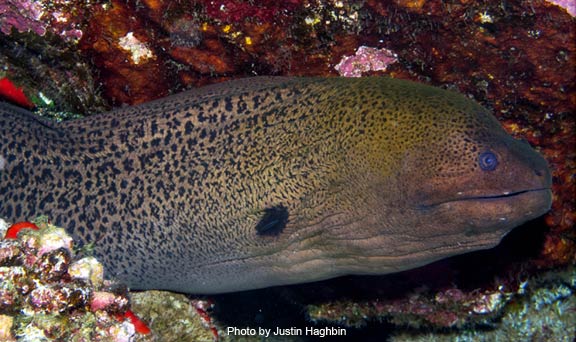
Giant Moray (Gymnothorax javanicus). Outer western slope of Molokini. Aug. 21, 2013. Photo by Justin Haghbin.
Over the next few months Giant Moray sightings continued to be made by Justin and others. But not within just a 10- or 20- or even 50-foot radius like other species of morays we have known. These sightings were sometimes a half-mile apart! So, we wondered, is it a different Giant Moray at all of these places? Or the same individual? Odds were that it was the same individual, since the species is so rare in Hawaii. But we had to know for sure.
Fortunately, like most animals, there are identifying characteristics if you look closely enough. The Giant Moray has tiny black spots all over its body. So, we compared the spot pattern on the right side of the face in photos taken in the three locations – on the back wall, on the outer western slope and at Enenue. As you can see, the spot pattern is identical.
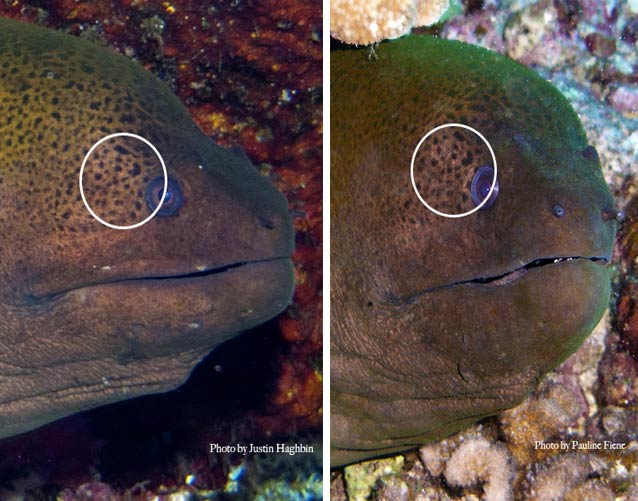
Showing identical crescent moon spot on the Giant Moray photographed a quarter-mile or a half-mile apart, depending on the route it took. Photo on left taken on Aug. 21, 2013 on the outer western slope of Molokini. Photo on right taken Sept. 18, 2013 at Enenue, the inner eastern slope of Molokini.
Molokini is about 0.4 miles in diameter and about 1.3 miles in circumference. Just moving from the outer western slope clock-wise around to Enenue one time is a trip of about half a mile, and it has done this several times that we know of. Then there have been several visits to the back wall, about 1/4 of a mile from the outer western slope. Added up, this eel has swum miles around the perimeter of Molokini in just the few months that we have been aware of its presence.
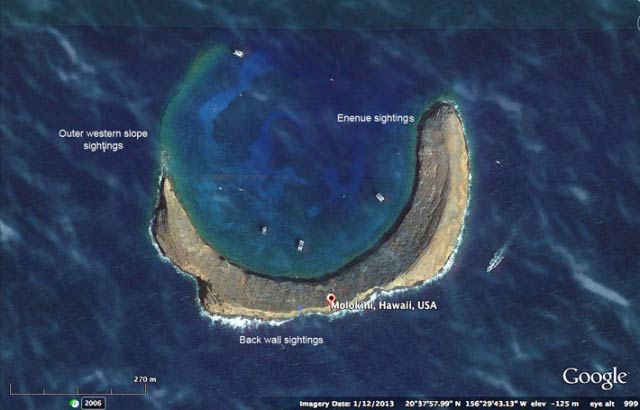
Approximate locations of Giant Moray sightings at Molokini, summer, 2013.
We are not aware of reports of a moray eel traveling such distances, so we asked eminent fish scientist Dr. Jack Randall, and Dr. John McCosker, Senior Scientist at the California Academy of Sciences and moray behavior expert. Neither had heard of such long-distance movement by a moray.
Morays that we have known have remained in roughly the same location for years, possibly a decade or more, and some divers have reported that they have visited the same moray eel in the same place for at least 20 years. What would cause this Giant Moray to move around so much? Being such a rare eel in Hawaii, perhaps this individual is expending all this energy in search of a mate, something it would not have to do in areas where it is a common species.
Such discoveries are exactly the kinds of things that dive guides have a unique opportunity to document. All it takes is paying attention (and usually a camera) to document marine life behavior that has never been observed before, because while dive guides spend only a tiny fraction of their lives underwater, it is still more than most professional scientists are lucky enough to spend.
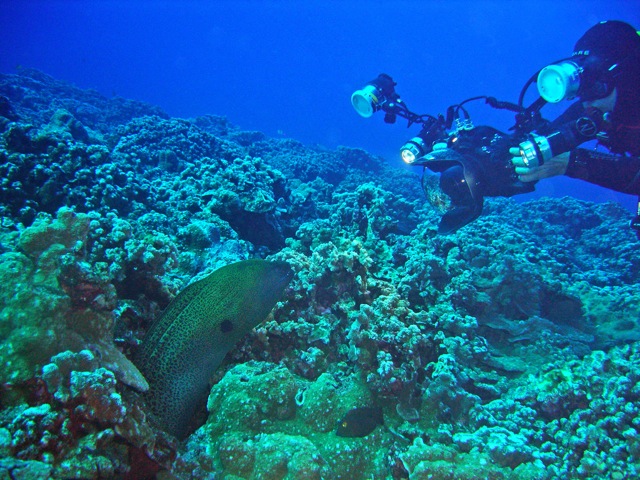
Giant moray being photographed inside Molokini by Benja Iglesis, Dec. 4, 2018.
UPDATE: This same individual has been sighted numerous times in various places inside and outside Molokini Crater since the first sighting on Aug. 21, 2013. On Dec. 4, 2018 s/he was seen inside Molokini Crater, partly extending from a hole in the reef (photo above). S/he was seen on Sept. 25, 2019 by Monica and Tony Christler and then by us on Jan. 22, 2020. We didn’t see him/her again for a whole year until Jan. 7, 2021 (photo below). You can see how beefy his head has gotten since we first saw him/her in 2013. Our latest sighting: March 16, 2021.
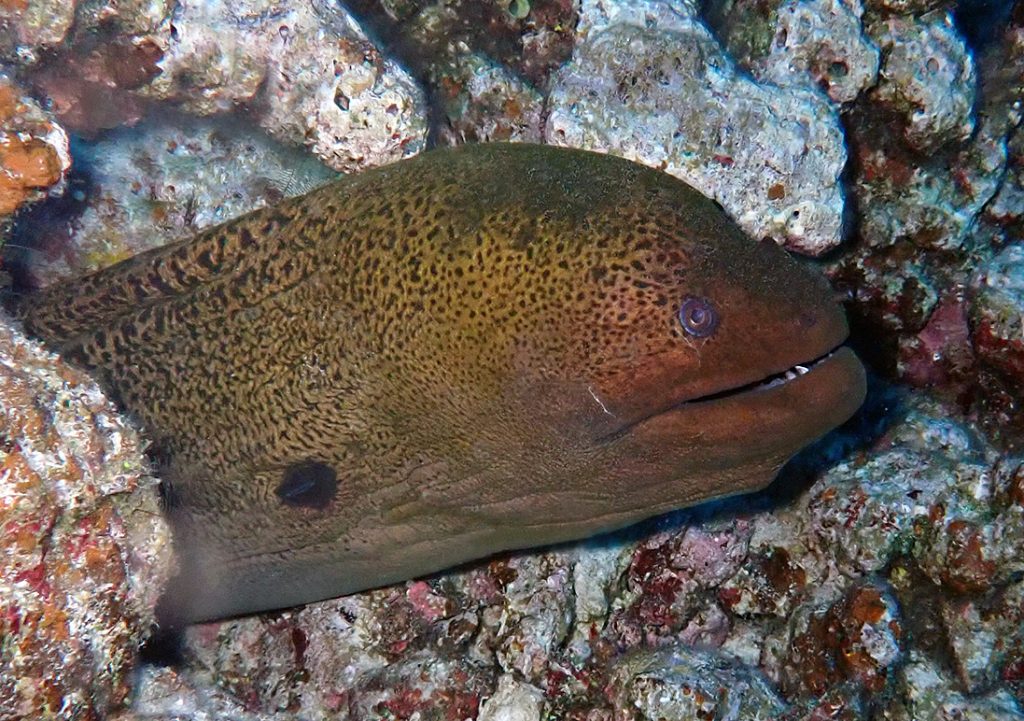
By Pauline Fiene. Photos as credited.
* the specimen at the Bishop Museum had been caught on hook and line (sharkline) off Milolii, Kona Coast of Hawaii, in Oct. 1977. It was a male 6.7 feet long and weighed 69 pounds. Information courtesy of Arnold Suzumoto, Ichthyology Collections Manager at Bishop Museum.

Comments 4
Given the fact that they are so rare in Hawaii, where would this one have most likely come from? Did he migrate to Molokini over some great distance? Really fascinating stuff, thank you for sharing it!
Author
Thanks, Dan! Any giant morays that show up in Hawaii have arrived as larval eels drifting in from farther out in the Pacific. Then they choose a place to live, begin to transform into the adult eel and begin life on a reef. I would guess that this one arrived in larval form and has been at Molokini for quite some time. Maybe even a few years given its size. We rarely see tiny juveniles of even common species – they are just so good at hiding when young. There was a pair living in one of the Lanai Cathedrals for years that many many divers saw, but I was not lucky enough to ever see them.
That’s pretty neat. Sad, though that he’s not likely to find a mate.
Wow! Great pics. We also have seen giant moray eel in Bora Bora. Posted a poor video at https://www.facebook.com/ScubaFit. We have been to Molokini Crater several times including the back wall. Always new and incredible creatures there. On one occasion watched a couple of morays fighting over a fish. Another time a pair of manta rays. Looking forward to coming back.